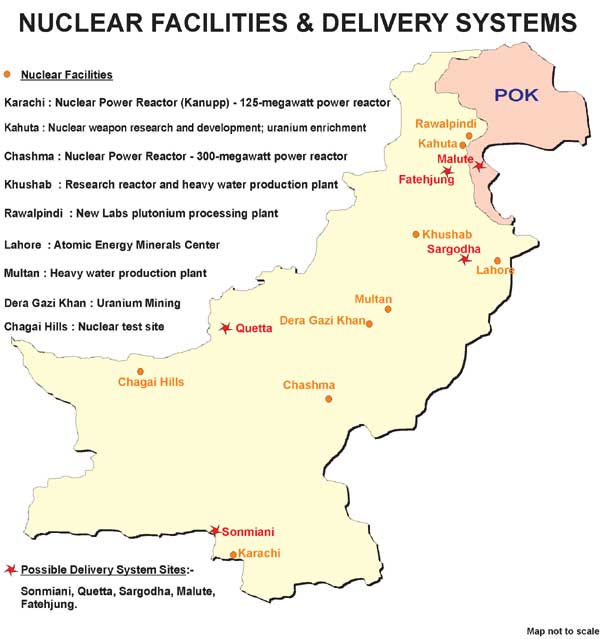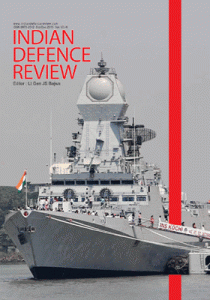Hatf IX (Nasr) is a Pakistani ballistic missile which can deliver a sub-kiloton nuclear warhead over a range of 60 km, or 37.3 miles. It is supposed to have entered service in 2013 and is believed to be fully integrated into Pakistan’s C3I (command, control, communications and intelligence). Its purported role is as a low-yield battlefield deterrent against mechanised columns. Should India – and the world – take Nasr seriously?
…there is a much greater possibility for tactical nuclear weapon to fall into ‘wrong hands’ due to theft, pilferage or sabotage.
The development and deployment of Nasr by Pakistan was inevitable and the impact of this tactical nuclear weapon (tac nuke) on the emerging India-Pakistan deterrence relationship is inherently destabilising.
Defining Tactical Nuclear Weapons: The Pakistani Context
There are four different yardsticks by which tactical nuclear weapon could be defined and classified. The first is the range of the missile: it must be short range, that is less than 80-100 km. The second is yield of warhead, conventionally benchmarked at less than 5 kilotons (kT) with reference to a 1994 US Congressional definition prohibiting R&D in US nuclear weapons laboratories below this yield. The third is function – Pakistan would use its tactical nuclear weapons in an anti-armour role; bunker busting is the primary role envisaged by US proponents of research into low yield nuclear weapons. The fourth yardstick is impact, which in the case of tactical nuclear weapon is limited to the immediate battlefield, or in other words, the sub-theatre.
Tactical Nuclear Weapons: Problem than a Solution?
Why are tactical nuclear weapon usually seen as a problem rather than as a solution? In the first place, they lower the nuclear threshold by blurring the distinction between conventional and nuclear war. Secondly, tactical nuclear weapon accentuate the ‘always-never dilemma’ inherent in all nuclear weapons: they must always work when you want them to, yet never be used when you do not want them to be used. The possibility of unauthorised or accidental use increases significantly with tactical nuclear weapon: unlike ballistic missile submarines (SSBNs), whose commanders have delegative control, in the case of tactical nuclear weapon delegative control may go down to subaltern/NCO levels under battlefield conditions. Thirdly, battlefield deployment of tactical nuclear weapon, especially in situations of rapid armour movement, creates an enormous pressure to ‘use them or lose them’. Finally, there is a much greater possibility for tactical nuclear weapon to fall into ‘wrong hands’ due to theft, pilferage or sabotage.
No matter how many internal security challenges it faces, Pakistan will not drop its guard vis-à-vis India and will always give the external threat primacy. In such an identity construction, nuclear weapons give Pakistan and its people the assurance of national survival…
Given these problems, all of them well known for decades, why has Pakistan gone down the tactical nuclear weapon route? In order to understand why, it is important to underline that Pakistan has, from even before South Asia’s overt nuclearisation, signalled a nuclear doctrine of not only first use but also early use. This doctrine has created problems for Pakistan, whose nuclear planners have had to grapple with the issue of nuclear thresholds, that is the point beyond which Pakistan would have no option but to use its nuclear weapons. As far back as 2002, the Landau Network–Centro Volta team (Cotta-Ramusino and Martellini) had identified four Pakistani thresholds: geographic (space threshold), military, political (domestic destabilisation) and even economic. Tactical nuclear weapon are Pakistan’s solution to the military threshold.
Pakistan’s Tactical Nuclear Weapons: Here to Stay
There are three essential features of Pakistan that suggest that its tactical nuclear weapon are here to stay. Firstly, as the weaker power in the India-Pakistan dyad, Pakistan faces significant conventional asymmetries. Only nuclear weapons provide Pakistan with a sense of strategic parity with India. Faced with the possibility of an Indian armoured thrust in the plains or desert sectors, Pakistan is signalling that it will use its tactical nuclear weapons despite their escalatory potential.
Secondly, Pakistan is a quintessential ‘homeland state’ with deep existential anxieties. Its entire national identity has been constructed as a homeland for an endangered people facing a historically implacable foe. No matter how many internal security challenges it faces, Pakistan will not drop its guard vis-à-vis India and will always give the external threat primacy. In such an identity construction, nuclear weapons give Pakistan and its people the assurance of national survival and civilizational certitude that they are second to none. Furthermore, they encapsulate the sense of ‘we will all go together when we go’ – akin to the Samson Option of that other nuclearised homeland state, Israel.
Finally, Pakistan is a revisionist power that has systematically pursued asymmetric strategies to overturn the territorial status quo. In this context, the nature of the ‘Kashmir issue’ comes into sharp focus. As a wise person once said of the Kashmir issue, ‘Kashmir is with India, the issue is with Pakistan.’ While admittedly a neat play on words, this observation identifies two core elements in the ‘shadow of the future’: (1) The Kashmir issue will be resolved only when Pakistan considers it resolved; (2) any change in the territorial status quo would be inimical to India. Pakistan’s dilemma is the nuclear weapons give it strategic parity but also buttress the territorial status quo. This explains why Pakistan has no compunction in deliberately shortening its nuclear fuse vis-à-vis India by deploying tactical nuclear weapon.
An arms control agreement between India and Pakistan over tactical nuclear weapon is unlikely: there is no incentive for Pakistan to remove a redline that begins at the international border (IB) itself. The strategic challenges that Pakistan’s tactical nuclear weapon pose for India will be explored in a future column.







INDIA too should go for tactical nuclear weapons and hand them over to our JCO’s